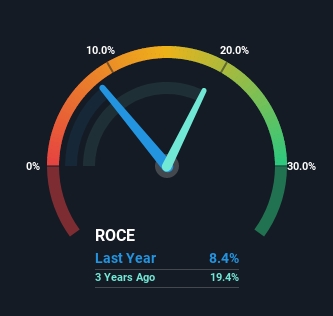- India
- /
- Consumer Durables
- /
- NSEI:JCHAC
Johnson Controls-Hitachi Air Conditioning India (NSE:JCHAC) Will Be Hoping To Turn Its Returns On Capital Around
Finding a business that has the potential to grow substantially is not easy, but it is possible if we look at a few key financial metrics. Firstly, we'll want to see a proven return on capital employed (ROCE) that is increasing, and secondly, an expanding base of capital employed. Put simply, these types of businesses are compounding machines, meaning they are continually reinvesting their earnings at ever-higher rates of return. However, after briefly looking over the numbers, we don't think Johnson Controls-Hitachi Air Conditioning India (NSE:JCHAC) has the makings of a multi-bagger going forward, but let's have a look at why that may be.
What is Return On Capital Employed (ROCE)?
If you haven't worked with ROCE before, it measures the 'return' (pre-tax profit) a company generates from capital employed in its business. To calculate this metric for Johnson Controls-Hitachi Air Conditioning India, this is the formula:
Return on Capital Employed = Earnings Before Interest and Tax (EBIT) ÷ (Total Assets - Current Liabilities)
0.084 = ₹701m ÷ (₹12b - ₹3.6b) (Based on the trailing twelve months to December 2021).
Thus, Johnson Controls-Hitachi Air Conditioning India has an ROCE of 8.4%. Ultimately, that's a low return and it under-performs the Consumer Durables industry average of 13%.
See our latest analysis for Johnson Controls-Hitachi Air Conditioning India

Historical performance is a great place to start when researching a stock so above you can see the gauge for Johnson Controls-Hitachi Air Conditioning India's ROCE against it's prior returns. If you want to delve into the historical earnings, revenue and cash flow of Johnson Controls-Hitachi Air Conditioning India, check out these free graphs here.
What Does the ROCE Trend For Johnson Controls-Hitachi Air Conditioning India Tell Us?
When we looked at the ROCE trend at Johnson Controls-Hitachi Air Conditioning India, we didn't gain much confidence. To be more specific, ROCE has fallen from 23% over the last five years. However, given capital employed and revenue have both increased it appears that the business is currently pursuing growth, at the consequence of short term returns. If these investments prove successful, this can bode very well for long term stock performance.
On a related note, Johnson Controls-Hitachi Air Conditioning India has decreased its current liabilities to 30% of total assets. So we could link some of this to the decrease in ROCE. What's more, this can reduce some aspects of risk to the business because now the company's suppliers or short-term creditors are funding less of its operations. Some would claim this reduces the business' efficiency at generating ROCE since it is now funding more of the operations with its own money.
The Key Takeaway
While returns have fallen for Johnson Controls-Hitachi Air Conditioning India in recent times, we're encouraged to see that sales are growing and that the business is reinvesting in its operations. These trends don't appear to have influenced returns though, because the total return from the stock has been mostly flat over the last five years. So we think it'd be worthwhile to look further into this stock given the trends look encouraging.
Since virtually every company faces some risks, it's worth knowing what they are, and we've spotted 2 warning signs for Johnson Controls-Hitachi Air Conditioning India (of which 1 can't be ignored!) that you should know about.
If you want to search for solid companies with great earnings, check out this free list of companies with good balance sheets and impressive returns on equity.
New: Manage All Your Stock Portfolios in One Place
We've created the ultimate portfolio companion for stock investors, and it's free.
• Connect an unlimited number of Portfolios and see your total in one currency
• Be alerted to new Warning Signs or Risks via email or mobile
• Track the Fair Value of your stocks
Have feedback on this article? Concerned about the content? Get in touch with us directly. Alternatively, email editorial-team (at) simplywallst.com.
This article by Simply Wall St is general in nature. We provide commentary based on historical data and analyst forecasts only using an unbiased methodology and our articles are not intended to be financial advice. It does not constitute a recommendation to buy or sell any stock, and does not take account of your objectives, or your financial situation. We aim to bring you long-term focused analysis driven by fundamental data. Note that our analysis may not factor in the latest price-sensitive company announcements or qualitative material. Simply Wall St has no position in any stocks mentioned.
About NSEI:JCHAC
Johnson Controls-Hitachi Air Conditioning India
Manufactures and distributes air conditioners, chillers, refrigerators, air purifiers, and variable refrigerant flow systems in India and internationally.
Flawless balance sheet with solid track record and pays a dividend.
Similar Companies
Market Insights
Community Narratives



